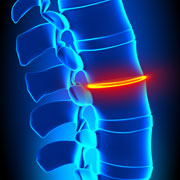When is laser spine surgery performed?
Laser spine surgery is used in patients who experience a broad array of spine conditions, including bone spurs, spinal stenosis, sciatica and facet joint disease. One of the most common uses of lasers in spine surgery is in the treatment of herniated discs. Two procedures are commonly used to treat discs that have become pressed and squeezed: laser endoscopic discectomy and percutaneous laser discoplasty. In laser endoscopic discectomy, damaged disc material is removed through laser ablation, releasing the nerve impingements and crowding that can cause painful symptoms in the arms and legs. In percutaneous laser discoplasty, laser energy is used to heat the herniated disc, shrinking the outer shell and increasing the space surrounding the disc to relieve pressure and impingement so the disc can function properly again.
Laser spine surgery can also be used for artificial disc replacement in place of fusion surgeries that join two or more vertebrae, preventing joint mobility in the affected portion of the spine. When motion is completely arrested, stress and strain can be transferred to neighboring areas of the spine, which in turn can become irritated and begin to cause symptoms of their own. Laser-assisted disc replacement procedures eliminate the need for fusion so the spine retains its flexibility.
Laser techniques can also be used to remove damaged nerves that send pain signals down the arms and legs in a procedure called facet ablation or rhizotomy.
In addition to removing damaged disc materials and repairing tears in the disc’s outer shell, laser spine techniques also help strengthen the disc, sealing injured areas to prevent the disc’s gel-like interior from leaking out and irritating surrounding tissues and nerves.
How is laser spine surgery performed?
Laser surgery is usually performed using sedation or local anesthetics so patients avoid the risks associated with deep general anesthesia. The specific technique used during a laser spine surgical procedure varies based on the condition being treated. In general, laser surgery uses a very small incision to admit a long, flexible tube to access the area of the spine that requires treatment. The tube can be used to visualize the treatment areas as well as serving as a conduit for the laser device, avoiding the need to cut through muscle tissue and limiting tissue damage for quick recovery. After the tissue is removed and repairs are made, the tube and instruments are withdrawn and the incision is closed.
What is recovery like?
Because laser spine surgery uses minimally invasive techniques with very small incisions and limited blood loss and tissue damage, recovery from most laser spine surgeries is relatively fast, and many patients are able to return home the same day they have their procedure. More extensive procedures with multiple issues such as herniation and bone spurs may require an overnight stay. Depending on the issue that’s treated, patients will need to avoid strenuous exercises, bending and twisting motions, and heavy lifting for several weeks. Before surgery, Dr. Jenkins will review what you can expect during recovery so you can plan appropriately.


